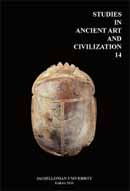Some remarks on the problem of the Horus falcon identification
Some remarks on the problem of the Horus falcon identification
Author(s): Tomasz PodgórskiSubject(s): Archaeology
Published by: KSIĘGARNIA AKADEMICKA Sp. z o.o.
Summary/Abstract: The problem of possible identification of the sacred falcon of Horus with an actual bird species has been puzzling Egyptologists for a long time. Prior to focusing on more detailed considerations, it seems appropriate to recollect the main aspects of this bird’s appearance in the ancient Egyptian iconography. The representation of the falcon in Egyptian art displays, apart from some minor variations, amazing stability in the course of about two millennia, and this statement applies both to the squatting and hovering falcon. A classic shape of the former was invented as early as the 1st Dynasty, as testified by a fine example on the stela of King Djet (Fig. 1), and ever since a reposing falcon appeared in innumerable instances to the very end of the pharaonic Egypt, mainly as the crowning of the royal Horus name, as is the case of the rock relief of King Snofru from Wadi Maghara (Fig. 2), or as a hieroglyphic sign. Exquisite examples come from the New Kingdom. A painted falcon from the temple of King Thotmes III at Deir el-Bahari on block F 6639 (Fig. 3), according to the epithet s3b šwt, has the abdomen and part of the head cream-white, whereas the wings are bichrome, with blue speckles scattered on greenish background. The long tail feathers (always six in this temple) have identical colours, but their tips are red. Parts of the head and nape are adorned with a specific pattern of blue arrowheads and speckles on green background. The bird has a peculiar facial moustache. This entire combination of colours was of immense magical significance.
Journal: Studies in Ancient Art and Civilization
- Issue Year: 2010
- Issue No: 14
- Page Range: 67-72
- Page Count: 6
- Language: English

